Creating a BUZZ: Attracting SCI/TECH Students to the Library!
Information Services Librarian
mary.axford@library.gatech.edu
Ray Bedner
Information Services Associate
ray.bedner@library.gatech.edu
Cathy Carpenter
Assistant Department Head, Special Formats & Maps
cathy.carpenter@library.gatech.edu
Lori Critz
Assistant Department Head, Information Services
lori.critz@library.gatech.edu
Leslie Madden
Instruction Librarian
libmlm@gsu.edu
Brian Mathews
Information Services Librarian
brian.mathews@library.gatech.edu
Crystal Renfro
Information Services Librarian
crystal.renfro@library.gatech.edu
Joanne Tobin
Information Services Librarian
joanne.tobin@library.gatech.edu
Georgia Institute of Technology
Atlanta, Georgia
Abstract
In the land of the Georgia Tech Yellow Jackets, we are "swarming" the campus with a multi-targeted publicity campaign. The Library's newly formed Information Services Marketing Group has launched several dynamic initiatives in 2005 -- all in an effort to raise the profile of the Library, to increase gate count and resource usage, and to expand campus-wide partnership opportunities in a fast-paced urban environment.The urban campus of Georgia Tech stands on a woodland fringe of the once-small Southern city of Atlanta, at the center of what is now America's tenth largest metropolitan area. Skyscrapers rise from the forest canopy, and with numerous institutions of higher education, better than average job creation, and consistent population growth, the Atlanta region enjoys a more youthful demographic than the US as a whole. In such a dynamic setting, there is no shortage of city pleasures -- cultural, athletic, and social -- to divert Tech students from thoughts of work and study. Georgia Tech students are, however, self-motivated and focused, as well as technically savvy. With the ever-increasing addition of remotely accessible electronic resources, students can now often complete their research without the previously requisite visits to the library. Keeping users interested in the library's multitude of services and resources, giving users reasons to get excited about their next library visit, and reinforcing the library's centrality to the Georgia Tech experience, are therefore the challenges addressed by the library's Information Services Department PR Marketing Group.Shattering the image of the library as a book mausoleum, our new programs include Tuesday Talks, an afternoon speaker series spotlighting exciting campus research, and T-Paper, a hip, student-oriented restroom newsletter. Emerging projects include a stereotype-bursting library entry in the University's Homecoming Parade and posters of "STAR" student-athletes promoting library resources.
The Marketing Group is meeting some key challenges facing today's academic science libraries, by fostering campus connections, creating new collaborative opportunities with faculty, and helping to rebrand our Library as a progressive 21st century "apiary."
In 2004/2005, the Information Services Department spent considerable time and effort developing a strategic plan to direct the future vision and work of the department. Key issues became apparent during this process, and one of the central components was clearly marketing and public relations.
In this strategic planning process we identified our key market segments: Georgia Tech undergraduate students, graduate students, faculty, researchers, and academic professionals. Visitors from the general community and alumni were also included in our marketing plans, but were not to be our primary emphasis. We identified most of the traditional methods of communicating with these myriad groups such as e-mails, brochures, ads in campus publications, posters, and classes.
While we continue to pursue traditional avenues as appropriate, the department agreed that "something new" was needed to catch the attention of our technology minded students and faculty. From this realization, the PR Marketing Group was formed, and then tasked to create and implement an innovative, proactive marketing strategy. The strategy developed by the group led to the initiation of several dynamic new projects: a speaker's series (Tuesday Talks), an in-house newsletter directed at students and visitors in the library (T-Paper), and a campaign of promotional posters featuring student athletes.
Tuesday Talks
Starting in the spring of 2005, the PR Marketing Group initiated a series of informal lectures showcasing Georgia Tech faculty. Called Tuesday Talks, these open-to-the-campus speaking events are held in the library the last Tuesday of the month during the fall and spring semesters.The series seeks to bring researchers out of the lab and into the library to make their work understandable to all of us in the Georgia Tech community. Its advertising motto is "Research for all of us!" By being fun, informative, interactive sessions which offer audiences unique insight and access to our renowned faculty, we hope that the talks convey the "essence" of the Georgia Tech campus as a forward-looking institution, with the library as not only its information repository and research center, but its social, cultural, and intellectual center as well.
Speakers are recruited by our librarians/Information Consultants from their teaching and/or research faculty in their respective departments. Their charge is to seek out dynamic, entertaining speakers immersed in cutting-edge research who could present their studies to the layperson. Each talk is viewed as a unique event -- and in each case the results and tone has varied. Our emphasis is on the "Talk" moniker, as the series is not meant to be a formal lecture or a "classroom in exile." We are mindful of the possibility of a less than engaging speaker. On one occasion, the speaker lost sight of this vision, presenting in a pedantic or didactic manner, with the result being a non-event that lacked the excitement resident in the more informal entries. We have yet to determine the foolproof method for selecting the vivacious, crowd-pleasing presenters we seek, but know that the desired "tone" of the event must be communicated to the speakers early in the planning/preparation stage to ensure success.
"Spontaneous" may be the Talks' watchword, but a considerable amount of behind-the-scenes work goes into making each Talk a success. PR Marketing Committee members spend significant time scheduling busy speakers, often months in advance of their speaker date. Promotional print materials are planned, produced, and distributed just in time. Web postings and e-messages are deployed to help spread the word. Public address messages are written and announced within the library on a preplanned schedule.
Event day preparation includes rearranging furniture in a room typically used for meetings and conferences into a public seating configuration able to comfortably and safely accommodate up to 80 plus attendees. Refreshments and snacks are purchased, stored, and made available to guests before and after the event. Every talk is videotaped, necessitating audiovisual set-up, followed by the conversion of the footage to DVD, and subsequent digital archiving to the library repository, SmarTech. The Library Information Consultant who scheduled the speaker welcomes attendees, introduces the speaker at the Talk, and at the conclusion, presents the speaker with a professionally framed event poster. Attendee feedback forms are distributed collected, and results studied. These well-rehearsed logistical dances are repeated with each new topic, each new speaker, and each new event.
All of our print advertising materials carry the branding we have developed. Eye-catching colors and graphics produce a recognizable, memorable visual that will remain associated with the continuing event. Early on, we attempted to saturate the campus with radio and newspaper ads, posters, flyers, etc. We learned from exit surveys that most attendees found out about the event via in-house advertising --- including our prominently displayed posters, giveaway flyers and day-of-event PA announcements. The committee was especially gratified to learn that attendees often find out about the event from items we place in our in-house restroom newsletter, the T-Paper. This last-minute decision-making seems in line with what we know about Georgia Tech students. They are, like our faculty, highly motivated, extremely busy sometimes to the point of over-commitment, and are most likely to attend an event like this on the spur of the moment rather than as a planned activity. Based on this feedback, we have decided, for the present, to continue our in-house advertising, targeted e-mails to our research staff and faculty, and the posting to both print and web-based Georgia Tech calendars -- but have discontinued most other outside promotional avenues.
Attendance has been excellent, and response has been overwhelmingly positive. In most cases we have had room capacity crowds (65 - 85 attendees). Our audience has been mainly students. We have had a "smattering" of teaching/research faculty attend, as well as numerous library faculty, and hope to increase the faculty numbers over the coming year. Although we have not determined an appropriate approach, we know that we need to "cast a wider net" to successfully lure faculty from their desks and labs to the library on a Tuesday afternoon!
Audiences have been highly engaged and enthusiastic and the events' Q & A portion are a crowd favorite. The one instance when the audience seemed less than engaged, it was discovered through exit responses that the attendees were under a "mandate" to attend by class professors, and therefore they did not necessarily have an innate interest in the subject or the speaker. More typically, however, attendees are excited to discover that they can make informal connections with the researchers and often stay after the Series to interact with the faculty at a personal level, asking questions relevant to their own interests or querying the faculty on "next steps" as students with a vital, future-directed interest in the field. For the presenters, an opportunity to "recruit" for their field is apparent; and on a personal level, junior faculty have a vitae-building opportunity as well, with an invited presentation directed at a (potentially) very large audience being an attractive entry to tout their accomplishments.
Our first offering in the Tuesday Talks series was in February of 2005. Dr. Steve Potter of the Georgia Tech Department of Biomedical Engineering, ("Hybrots: Using Cultured Neurons to Control Robots & Study Learning") dazzled a standing-room only crowd in the library's ground level presentation room. This animated, highly engaging inaugural "performance" set the benchmark for future Talks at a very high level, and left the audience stimulated, entertained, and eager to know more about neural networks and the possibilities of artificial intelligence. Subsequent speakers have included engineers, scientists from the College of Computing and various centers on campus, and professors from our Ivan Allen College of the liberal arts. Some have been in the "celebrity" status realm: Dr. Thad Starner spoke on his wearable computers and has, for example, previously been spotlighted in such well-known venues as 60 Minutes and Nova. Dr. Ifran Essa has been nationally recognized for his work on the Aware Home over the past five years. Others are just beginning their rise as Georgia Tech researchers. Topics have ranged from Fuel Cells and the Energy Challenge to Sports Scheduling using Optimization Techniques to the Roles of Women and Technology in Postwar Science Fiction.
Regardless of the presenter's position or level of recognition in the world community, the Information Services Department PR Marketing Committee's goal remains the same: to help researchers present their work in understandable and entertaining ways, with attendees energized over the key investigations underway at Georgia Tech. All the while, we strive to put the thought in the minds of participants that the library has provided a valuable service to the Georgia Tech community through its role as "host'"and "liaison" between outstanding thinkers and all of us curious and excited by the opportunity to connect to their important work.
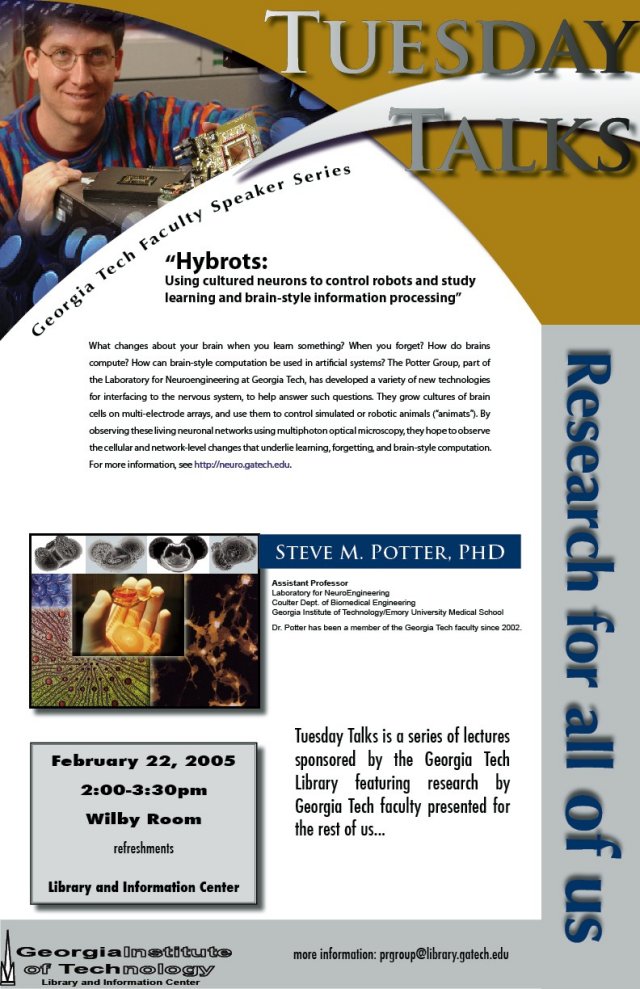
T-Paper
About the same time we began planning the Tuesday Talks lecture series, we also developed the T-Paper. T-Paper is a restroom newsletter designed to promote library resources and activities in a humorous and entertaining way. The idea came from an article in C&RL News (Van Zandt 2004) in which a librarian at The College of William and Mary described the success of their restroom newsletter, The Throne. We thought that this type of marketing would work well with Georgia Tech students and set about creating a prototype. Taking another cue from William and Mary, we came up with the eye-catching name, T-Paper, a tongue-in-cheek pun on the newsletter's location and the name of the institute (Tech). Next, we made decisions about size, placement, frequency, and content for the newsletter. We chose 11 x 17 paper because we could use larger font sizes, the standard paper size would be readily available, and could be produced from most printers. We decided to place the newsletter in stalls or above urinals, and near the sinks in the restrooms, reasoning that these would be the most likely places that people would see and read them. Plastic sleeves were purchased to hold the issues and keep them neat and clean. Issues we typically designed to come out once a month, but during low-traffic times in the library, such as semester breaks, we produce them less frequently. T-Paper usually features four or five distinct text or information areas, highlighting library events, resources, and other important information.William and Mary's newsletter is largely text-based, with short articles detailing new collections, library events, and resources. Initially, T-Paper was formatted similarly; however, since, most of the members of our PR team were over 35 years old we felt it was critical to get an 18 year-old's perspective early in the design process. We realized that what would appeal to us could be very different than what would appeal to the younger generation. Therefore, we created a student focus group for feedback on the design and content of our inaugural T-Paper prior to its launch.
We gathered a group of nine undergraduate students, the majority of whom were freshmen. During the focus group, we showed the students three mock-ups of the T-paper, each with somewhat different text and design. We asked the students for their impressions of each version, suggestions for content and how they would improve the paper. They were then invited to rank the papers from the best to the least favorite and to provide additional feedback. Examples of some of the comments: "too wordy," "design sucks," "too basic (T-Paper on plain white background)," "patent information helpful," "more sports trivia," "having something to read in the bathroom is a great idea," "like the name-very funny," "good idea to change the layout each month."
Overall, we felt that the time and extra effort of enlisting a student focus group was one of the most important steps in the development of the T-Paper. The focus group session helped us to develop a much clearer understanding of what the students would find attractive to read, and our initial concept was scrapped in favor of a more visual design that would get the information across quickly with a minimum of words. Working with in-house expertise, and redesigning with our students in mind, T-Paper became more modular, using bolder background colors with a layout containing some sense of movement and diagonal direction, rather than just a traditional newspaper grid system. Our inaugural issue in February 2005 contained graphics and colored, short blocks of text. The students immediately noticed, and featured T-Paper in the "What's Hot" column in the next issue of the campus newspaper.
Each issue has a unique theme. The March issue, for example, was themed "Surf's Up For Spring Break." Graphics of a surfer made the issue visually appealing, but also drew the eye to information about a new state-wide book delivery system. Additionally, the issue included library hours for Spring Break, a listing of upcoming library classes, information about our library lecture series, Tuesday Talks, and a "wacky patent" for Aquatic Golf.
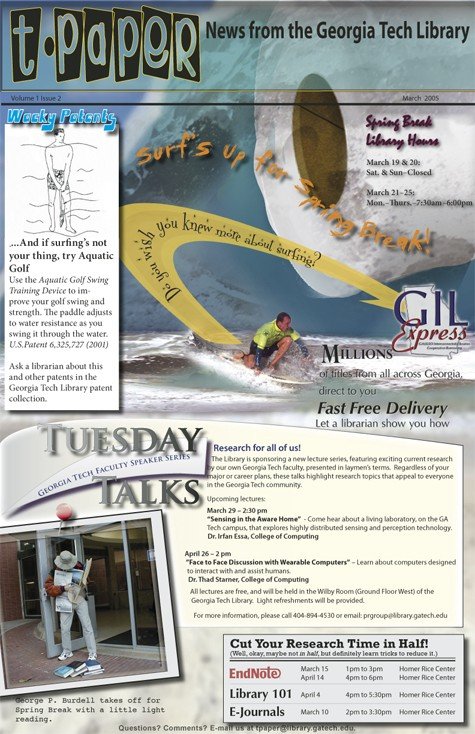
The Georgia Tech Library is a U.S. Patent and Trademark depository. Highlighting an unusual or "wacky" patent for a bit of humor, but also to promote usage of this important collection was one goal we set early in the production process. Preliminary feedback from our student focus group indicated the popularity of our "wacky patent" feature, convincing us to make this a recurring feature.
Other themed issues have included a baseball theme to coincide with baseball season at Tech, a construction theme to go along with renovations in the library, an ice cream theme for the summer issue, science fiction and alternative energy themes to promote Tuesday Talks lectures, and a history by the decades issue (complete with Tech library photographs) during the month of National Archives Week.
We suspect that library users typically do not stop to read building signs or announcements on our homepage. With T-Paper we have striven to inform them about our resources and events in a non-traditional, fun and sometimes irreverent way, in the hopes of dispelling the myth that libraries and librarians are stuffy, unfriendly, and unwelcoming.
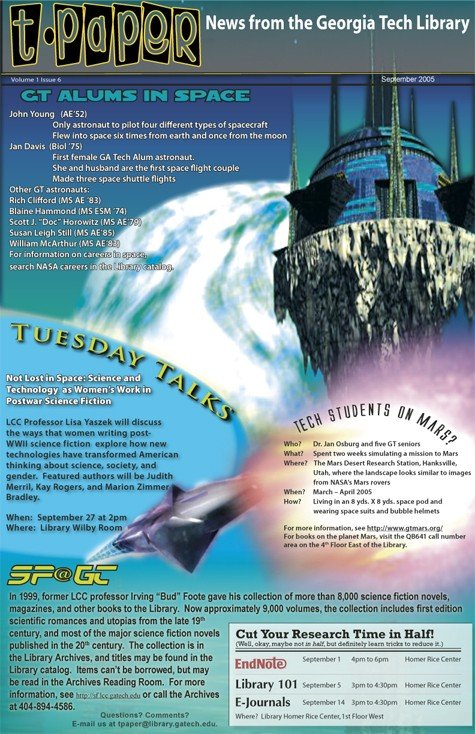
Student-Athlete Posters
The success of the Tuesday Talks lecture series and the T-paper led us to try yet another way to market the library. Inspired by ALA's READ poster campaign, we wanted to create a personalized series of promotional posters for the Library. Similar to ALA's posters, we wanted to feature campus celebrities, namely student-athletes. However, rather than spotlighting a favorite book, we intended to list our celebrities' athletic and academic accomplishments. Amongst these credentials would be library patron. We envisioned the posters sharing a similar look, yet intended to use them to promote various library services and resources, such as the information commons, our presentation rehearsal studio, the popular reading collection, and the availability of laptops, digital cameras, and video cameras.In Spring 2005, the Georgia Tech Men's Basketball team was highly ranked and we hoped to capitalize on this notoriety. A call to the Athletic Association quickly revealed that we were not the only ones interested in the team. Since collaboration with the Athletic Association was critical for success, we decided to delay the project and conduct photo shoots during the off-season. The Athletic Association agreed to work with us, but requested that they handle communications with the students. They also needed to obtain approval of the posters to be in compliance with the National Collegiate Athletic Association.
The selection of student-athletes turned out to be more challenging than anticipated, since there were numerous viable candidates. During the summer of 2005, we submitted two names and scheduled photo shoots with the students. Using a five mega-pixel digital camera, Photoshop, and the Library's plotter-printer, we created glossy, high-quality, colorful, 36 x 24 inch posters. The first poster was released early in the Fall 2005 semester and featured a prominent football player (P.J Daniels). The Georgia Tech Football team was highly ranked, so we hoped this would generate interest. Posters were placed in library display cabinets, as well in the student union and the campus recreational center. A second poster, featuring a female basketball player will be released in Spring 2006.
This project has provided several learning experiences. Beyond the necessary cooperation with the Athletic Association, the selection of appropriate students, and setting up the photo shoots, content is the primary challenge. Simply photographing a student athlete "studying" is not enough and we are striving for more actionable and compelling concepts. Cognitively, we hope students look beyond the persona and find value in the featured service or resource. We also discovered the limited amount of space on campus for displaying large posters, and are considering printing smaller versions, which could be positioned strategically in more places.
Casual observation has revealed that many students read the posters. As we continue to build the series, emphasizing different library components, we anticipate that the marketing effort will payoff with increased student interest and awareness of the Georgia Tech Library.
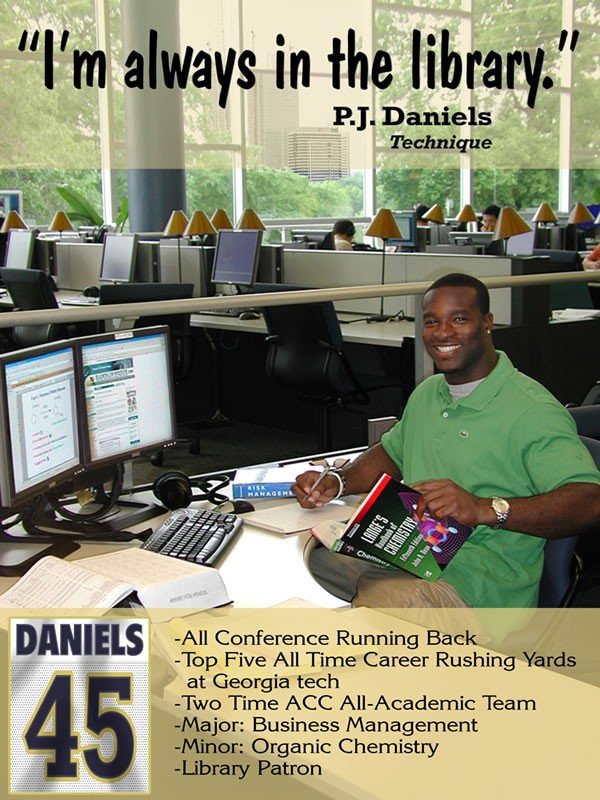
Conclusion
The PR-Marketing Group has learned several lessons from its activities. First we discovered the importance of having an in-house graphics person. College-age students are particularly drawn by attractive visuals. Our information associate Dottie Hunt has produced vibrant newsletters and posters that draw the eye. Secondly, it is important to get constant student feedback. The forms distributed at Tuesday Talks, for example, has helped focus our advertising.Overall, though one speaker may have been less than dynamic, and one T-Paper not a visual success, we feel that the projects described in this article have increased positive awareness of the Library and its place on the Georgia Tech campus. We are also agreed that working on such projects as T-Paper, Tuesday Talks, and student athlete posters is the most legal fun you can have in a library!
References
Van Zandt, P. 2004. "The Throne" Campus kudos for a unique library newsletter. College & Research Libraries News 65(1): 20.
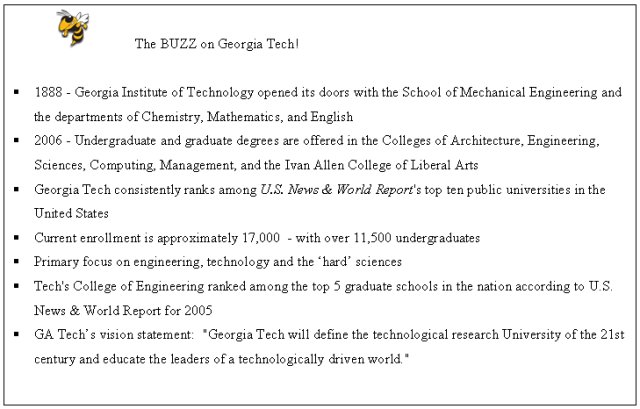
| Previous | Contents | Next |
